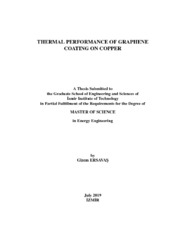Please use this identifier to cite or link to this item:
https://hdl.handle.net/11147/7413| Title: | Thermal Performance of Graphene Coating on Copper | Other Titles: | Grafen Kaplı Bakırın Termal Performansı | Authors: | Ersavaş, Gizem | Advisors: | Toprak, Kasım Çelebi, Cem Toprak, Kasım Çelebi, Cem |
Keywords: | Thermal conductivity Graphene Copper Moleculer dynamics simulations |
Publisher: | Izmir Institute of Technology | Source: | Ersavaş, G. (2019). Thermal performance of graphene coating on copper. Unpublished master's thesis, İzmir Institute of Technology, İzmir, Turkey | Abstract: | Over heat is always a problem for electronic devices because the locally generated
heat cannot be transferred appropriately to the corresponding heat sink fast enough. This
situation leads to affect materials’ structures, mechanical properties and conductivities
badly. In order to avoid this problem, high thermal conductivity materials are used to
dissipate the heat quickly.
Thanks to the development of technology, the size of the electronic devices is reduced
day by day. This also shrinks the size of the interconnect components. So this situation
leads to researchers to investigate nano-sized interconnect components and copper,
which is a widely used material, is one of them. Copper is one of the preferred metals for
electronic devices because of high thermal conductivity, easy processability, and high use
in daily life and industry. For example, copper components, which is used in electronic,
are getting so thin and must carry so much current. And that causes to increase friction.
Thus heat is occurred. Consequently, cooling problems have arisen. And if the material’s
cooling problem won’t be solved then the material can be damaged. It is thought
that to overcome this problem, coating with a high thermal conductivity material such as
graphene, the thermal conductivity can be improved. In this study, thermal performance
of graphene-coated copper were investigated numerically and experimentally.
This study consist of two main sections. The first part, MD simulation code was
created using C++ programming language to investigate thermal conductivity of copper,
different number of graphene layers and these graphene layers were coated on copper in
different length, width, height and temperature. In the second part, the thermal performance
of pure copper, annealed copper, a layer of graphene-coated copper, and multilayer
graphene-coated copper was studied by the experimental setup at three different
temperatures and volume flow rates. Yüksek ısı elektronik cihazlar için her zaman sorun oluşturmaktadır. Bunun nedeni, üretilen ısının uygun ve hızlı bir şekilde soğutucu tarafından atılamamısıdır. Yüksek ısının atılamaması malzemenin yapısını, mekanik özelliklerini, ısı ve elektrik iletimini kötü bir şekilde etkiler. Bu durumu önlemek için yüksek termal iletkenliğe sahip malzemeler kullanılarak, ısının hızlı bir şekilde atılması sağlanır. Teknolojideki gelişmeler sayesinde, elektronik cihazların boyutları gün geçtikçe azalmaktadır. Bu durum, elektronik cihazların içerisindeki bağlantı elemanlarının da boyutlarının küçülmesine neden olmaktadır. Bunun sonucunda, bazı araştırmacılar nanoboyutlardaki bağlantı elemanlarını incelemeye ve bu elemanların performansını iyileştirmeye yönelmiştir.Yaygın olarak kullanılan bir malzeme olan bakır da bunlardan biridir. Bakır yüksek termal iletkenlikleri, kolay işlenebilirlikleri, günlük hayatta ve sanayide çok fazla kullanılmaları yüzünden elektronik donanımlar için tercih edilen metallerdendir. Örnek vermek gerekirse elektronikte kullanılan bakır parçaların boyutları gün geçtikçe küçülmektedir ve çok fazla akıma maruz kalmaktadır. Bu durum bakır nanoteller içindeki direnci arttırır ve ısı oluşmasına neden olur. Bu da nanotellerde soğutma problemini ortaya çıkarmıştır ve eğer kullanılan malzemedeki soğutma probelemi çözülmez ise malzeme zarar görebilir. Bu problemlemin üstesinden gelmek için kullanılan malzemenin üzeri grafen gibi yüksek termal iletkenliğe sahip bir malzeme ile kaplanarak thermal iletkenliğinin iyilileştirilebileceği düşünülmektedir. Bu çalışma, grafen kaplı bakırın termal özelliklerini numerik ve deneysel olarak incelenmiştir. İki ana bölümden oluşan bu çalışmanın ilk kısmında C++ programlama dili kullanılarak bakırın, farklı sayıdaki grafen katmanının ve bu grafen katmanlarının bakır üzerine kaplandığı modelleri oluşturuldu ve moleküler dinamik simülasyon yöntemi kullanılarak thermal iletkenliğin değişimi farklı uzunluk, genişlik, yükseklik ve sıcaklıkta incelenmiştir. İkinci kısımda ise, saf bakırın, tavlanmış bakırın, bir katman grafen kaplamalı bakırın ve çok katman grafen kaplmalı bakırın termal performansı bir deney düzeneği kurularak farklı sıcaklık ve debide incelenmiştir. |
Description: | Thesis (Master)--Izmir Institute of Technology, Energy Engineering, Izmir, 2019 Includes bibliographical references (leaves: 57-61) Text in English; Abstract: Turkish and English |
URI: | https://hdl.handle.net/11147/7413 |
| Appears in Collections: | Master Degree / Yüksek Lisans Tezleri |
Files in This Item:
| File | Description | Size | Format | |
|---|---|---|---|---|
| T001960.pdf | MasterThesis | 12.28 MB | Adobe PDF |  View/Open |
CORE Recommender
Page view(s)
242
checked on Apr 21, 2025
Download(s)
818
checked on Apr 21, 2025
Google ScholarTM
Check
Items in GCRIS Repository are protected by copyright, with all rights reserved, unless otherwise indicated.